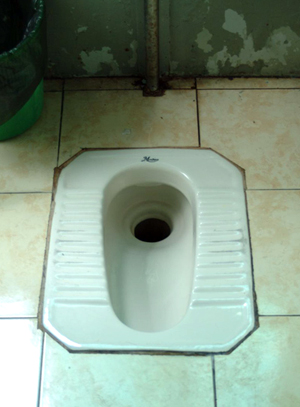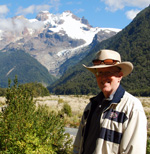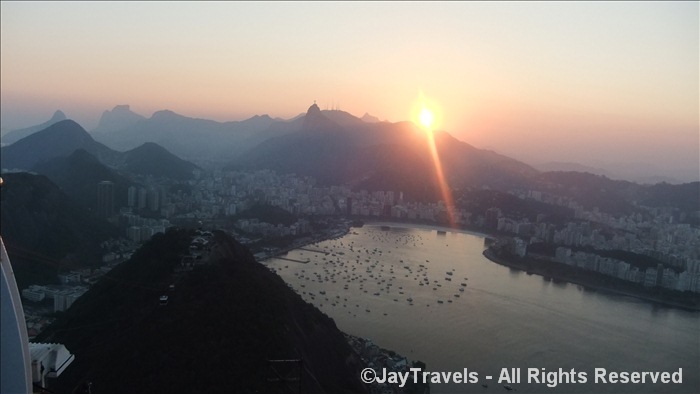Iguazu Falls was the second stop on my first South American adventure that took me through 5 cities in 3 countries. Over the course of nine days, I hit Rio de Janeiro, Iguazu Falls on the borders of both Brazil/Argentina, Colonia del Sacramento in Uruguay and finished off with Buenos Aires in Argentina.
Destination at a Glance |
||||
| Date of Trip | September 2010 | |||
| Destination Good for | Sightseeing, Adventure/Hiking, Pictures | |||
| Best Time to Go | Always hot – though winter (Dec-Feb) is most comfortable | |||
| Currency/Conv. Rate | Brazilian Real & Argentinean Peso | |||
| Good Way to Get Around | Rent Car: Yes | Public: Yes | Taxi: Yes | Walking: No |
| Appox. Trip Cost | Fairly Inexpensive | |||
| Speaks English? | Many | |||
| Entry Requirements | Passport and Visa for Brazilian side (must already have) | |||
| Do it |
|
|||
| Skip it |
|
|||
| Didn’t get to do |
|
|||
| Would I Recommend | Absolutely Yes | |||
| Overall Trip Rating | ||||
Trip Review (Click Thumbnails to see Full-Sized Images)
.jpg) Although situated between Brazil, Paraguay and Argentina, the falls themselves only exist in Brazil and Argentina. I’m not aware of any international flights originating outside of South America that flight directly to the falls, so the most popular connection points are from Rio, São Paulo, or Buenos Aries. From these spots, you can take domestic flights which are around the 2 hour mark. If in Brazil, you would fly into Foz do Iguaçu – the city that lines the Brazilian border of the falls. If coming from Argentina, you would fly into Puerto Iguazu – city that lines the falls on the Argentinean side. A bridge separates the two sides with each country’s flags painted along the bridge up to the midway point. Allow at least 30 minutes for your first border crossing, though subsequent crossings take less time to complete (you are still at the mercy of the lines to get to the checkpoint – which can be long).
Although situated between Brazil, Paraguay and Argentina, the falls themselves only exist in Brazil and Argentina. I’m not aware of any international flights originating outside of South America that flight directly to the falls, so the most popular connection points are from Rio, São Paulo, or Buenos Aries. From these spots, you can take domestic flights which are around the 2 hour mark. If in Brazil, you would fly into Foz do Iguaçu – the city that lines the Brazilian border of the falls. If coming from Argentina, you would fly into Puerto Iguazu – city that lines the falls on the Argentinean side. A bridge separates the two sides with each country’s flags painted along the bridge up to the midway point. Allow at least 30 minutes for your first border crossing, though subsequent crossings take less time to complete (you are still at the mercy of the lines to get to the checkpoint – which can be long).
Since I flew in from Rio into the Brazilian FOZ airport and drove across the border into Argentina, I did not have to pay the $130 reciprocal fee (it is only charged to US citizens on international arrivals at Buenos Aires’ EZE airport). There are also no visa fees for US citizens visiting Argentina. Special note to Americans attempting to visit the Brazilian side of the falls – you will need a visa. The visa is $140 for US citizens and cannot be paid at the border (there is a ridiculously long process that must be completed at one of their embassy/consulates in the US – either in person or by mail). There are stories on the web of the Brazilian border agents looking the other way and allowing entry – I wouldn’t base my vacation on the hope you find the ‘right’ agent to put their job on the line for you. Don’t ruin your plans by showing up with no visa, they will likely turn you away and even if they don’t; I suspect you’ll still need to cough up the $140 US and wait who knows how long for them to process the application. Since I was coming from Rio and already had my visa, this was a non-issue. You have been warned!
Regardless of whether you stay on the Brazilian or Argentinean side of the falls, there are only three hotels that are really close to the park (two are actually in the park itself). Just understand you will pay dearly for this convenience – $500 a night isn’t unheard of. The remainder of the hotels are around a 15-25 minute drive to the falls and many of them are complete dumps (at least from the outside as I drove by). Use Trip Advisor to find a highly rated boutique hotel; if someone says the property looked rundown or grimy – believe them. In terms of transportation, both airports have the usual Avis, Eurocar, etc. rental car agencies.
.jpg) Finally the weather – it’s hot. And humid. And hot. With a shit load of mosquitoes. And hot! Even in the dead of winter – the temperature is still around 80-85 degrees so you’ll need plenty of fluids to stay hydrated. In addition, head to toe bug spray is a must, as well as, synthetic clothing that wicks moisture away and dries quickly. The absolute worst thing you could do is wear denim/cotton jeans and cotton tee-shirt – once you get wet, you’ll never dry off. Did I mention it was hot???
Finally the weather – it’s hot. And humid. And hot. With a shit load of mosquitoes. And hot! Even in the dead of winter – the temperature is still around 80-85 degrees so you’ll need plenty of fluids to stay hydrated. In addition, head to toe bug spray is a must, as well as, synthetic clothing that wicks moisture away and dries quickly. The absolute worst thing you could do is wear denim/cotton jeans and cotton tee-shirt – once you get wet, you’ll never dry off. Did I mention it was hot???
The Falls
Here is a brief history of the falls mostly taken from Wikipedia:
Iguazu Falls (Iguaçu Falls in Portuguese) are waterfalls of the Iguazu River located on the border of the Brazilian State of Paraná and the Argentine Province of Misiones. The name “Iguazu” comes from the Guarani or Tupi words meaning “water”, and ûasú [waˈsu], meaning “big”. Legend has it that a god planned to marry a beautiful woman named Naipí, who fled with her mortal lover Tarobá in a canoe. In rage the god sliced the river, creating the waterfalls and condemning the lovers to an eternal fall. The largest waterfall in the entire park Devil’s Throat – is a U-shaped, 82-meter-high, 150-meter-wide, and 700-meter-long waterfall with its primary views being on the Brazilian side. Approximately two-thirds of the remaining waterfalls are on the Argentinean side.
You can visit both parks in a single day without rushing even in the winter when it gets dark earlier – you will just have to make two concessions. The first is you will need to hire a cab or rent your own car. I hired a driver for the entire day for 300 Argentinean Pesos (about $75) – not too expensive. You can certainly take the public bus system, however this is a considerably slower method. The second thing you’ll have to accept is you will be at the mercy of the weather. Neither of the parks will close unless there is severe lightening – but it’s difficult to take pictures and enjoy one’s self in a thunderstorm. Obviously if you have more than one day this is a non-issue.
.jpg) If you are going to do both parks in a day, I’d suggest starting on the Brazilian side because it is the shorter experience due to the trail essentially being in a straight line. The Argentinean side is more expansive – meaning multiple falls, multiple levels, and more walking. Unfortunately, the two park’s entrances are not close to each other. It takes about 20 minutes to drive between the two entrances excluding the time it takes to cross the border (which can be anywhere from 10 minutes to an hour). The entrance fee to Argentinean side is 100 AR$ per person (half off 2nd consecutive day) and 37 R$ to enter the Brazilian side.
If you are going to do both parks in a day, I’d suggest starting on the Brazilian side because it is the shorter experience due to the trail essentially being in a straight line. The Argentinean side is more expansive – meaning multiple falls, multiple levels, and more walking. Unfortunately, the two park’s entrances are not close to each other. It takes about 20 minutes to drive between the two entrances excluding the time it takes to cross the border (which can be anywhere from 10 minutes to an hour). The entrance fee to Argentinean side is 100 AR$ per person (half off 2nd consecutive day) and 37 R$ to enter the Brazilian side.
The Brazilian Side
.JPG)
.jpg) Similar to the Grand Canyon, pictures of Devil’s Throat (or any part of the falls) just doesn’t do it justice. You really can’t comprehend the scale and massive power of millions of gallons of water blasting over the edge of a cliff unless you are standing right next to it. Devil’s Throat’s lower viewing platform is by far the most exhilarating viewing platform in the entire park. From the end of the platform, you stand literally just yards away from the aforementioned millions of gallons of water splashing down with such intensity that a constant spray (nearly a shower) of water blankets the platform. You will get drenched! I strongly suggest using a parka (cheap ones are available in the gift shop) to provide some shelter for your camera/camcorder. As for the view itself, it’s just stunning!!!
Similar to the Grand Canyon, pictures of Devil’s Throat (or any part of the falls) just doesn’t do it justice. You really can’t comprehend the scale and massive power of millions of gallons of water blasting over the edge of a cliff unless you are standing right next to it. Devil’s Throat’s lower viewing platform is by far the most exhilarating viewing platform in the entire park. From the end of the platform, you stand literally just yards away from the aforementioned millions of gallons of water splashing down with such intensity that a constant spray (nearly a shower) of water blankets the platform. You will get drenched! I strongly suggest using a parka (cheap ones are available in the gift shop) to provide some shelter for your camera/camcorder. As for the view itself, it’s just stunning!!!
.jpg) I was able to get through the Brazilian side of the park at a leisurely pace in about two hours as going early and against traffic really helped. There is also a Jungle Safari and ATV tour offered on the Brazilian side. Looking at the park, there’s not an abundance of giant animals (there’s a few birds and plants) and the online reviews weren’t so hot, so I skipped them both. Just outside of the Brazilian side of the falls are two very good attractions worthy of consideration:
I was able to get through the Brazilian side of the park at a leisurely pace in about two hours as going early and against traffic really helped. There is also a Jungle Safari and ATV tour offered on the Brazilian side. Looking at the park, there’s not an abundance of giant animals (there’s a few birds and plants) and the online reviews weren’t so hot, so I skipped them both. Just outside of the Brazilian side of the falls are two very good attractions worthy of consideration:
- Pacquo Bird Park – Less than a 5 minute walk from the park entrance is this fascinating zoo with over 50 species of birds – everything from ostriches, flamingos, parakeets and toucans. Entrance was only $R18 and definitely worth an hour of your time.
- Helicopter Tour – Literally across the street from the bird park, this is a great way to get pictures/video of both sides of the falls from a completely different perspective. The 8-10 minute flight around the entire falls is only $R150 per-person.
The Argentinean Side
Upon entering the Argentinean side of the falls, you’ll be directed to the train that will take you to the Upper and Lower levels that departs about every 20 minutes or so. Free maps of both levels are available at the entrance of the park.
The Lower Level
.jpg) The lower level is certainly the most rewarding section of the Argentinean falls – but also the most challenging. There is significant walking – up and down stairs/hills – you must be physically fit to do this section. There are literally signs stating pregnant women, people with heart/breathing conditions and/or other physical limitations are prohibited. This section is certainly not wheelchair accessible. If you are able to successfully navigate the maze, you will find some of the most amazing natural views on the planet.
The lower level is certainly the most rewarding section of the Argentinean falls – but also the most challenging. There is significant walking – up and down stairs/hills – you must be physically fit to do this section. There are literally signs stating pregnant women, people with heart/breathing conditions and/or other physical limitations are prohibited. This section is certainly not wheelchair accessible. If you are able to successfully navigate the maze, you will find some of the most amazing natural views on the planet.
In addition to walking over, under and around several waterfalls, the bottom of the lower level opens up an entirely different experience – a boat adventure. This high-powered jet boat takes around 40-50 passengers for a thrilling ride up and down the river and almost under one of the giant waterfalls. While it’s too dangerous to actually go under any of the waterfalls, you will get close enough to feel the .jpg) thunder and power of millions of gallons of water crashing down just feet from the boat. And you will get totally drenched – a perfect way to cool off on a hot summer day. Tip: if you want to get more wet (like drenched down to the under garments) – sit on left side of boat since it continuously makes right turns causing the left side to be closer the current waterfall. You will be significantly less wet if you sit on the right side of the boat – but like I said, it’s relative – everyone will get wet. The company does provide a waterproof wet bag for your camera and personal belongings. Due to the amount of water, you really need a waterproof camera if you want to take pictures during the ride – though the company is filming the entire adventure and will sell you a copy of the event (I don’t know that cost since I used my own camera).
thunder and power of millions of gallons of water crashing down just feet from the boat. And you will get totally drenched – a perfect way to cool off on a hot summer day. Tip: if you want to get more wet (like drenched down to the under garments) – sit on left side of boat since it continuously makes right turns causing the left side to be closer the current waterfall. You will be significantly less wet if you sit on the right side of the boat – but like I said, it’s relative – everyone will get wet. The company does provide a waterproof wet bag for your camera and personal belongings. Due to the amount of water, you really need a waterproof camera if you want to take pictures during the ride – though the company is filming the entire adventure and will sell you a copy of the event (I don’t know that cost since I used my own camera).
.JPG)
The Upper Level
.jpg) The upper level offers the best panoramic views of the entire national park – meaning almost all of the Argentinean side’s falls, as well as, Devils Throat itself. The Argentinean Devil’s Throat viewing platform certainly isn’t as awe-inspiring as the Brazilian side’s near sea level perspective – but it’s an interesting vantage point nonetheless. The Brazilian side’s Devil’s Throat observation deck is at the bottom of the massive fall – the Argentinean side’s platform is a few hundred feet above the falls – looking down on the platform at other tourists getting drenched from the mist.
The upper level offers the best panoramic views of the entire national park – meaning almost all of the Argentinean side’s falls, as well as, Devils Throat itself. The Argentinean Devil’s Throat viewing platform certainly isn’t as awe-inspiring as the Brazilian side’s near sea level perspective – but it’s an interesting vantage point nonetheless. The Brazilian side’s Devil’s Throat observation deck is at the bottom of the massive fall – the Argentinean side’s platform is a few hundred feet above the falls – looking down on the platform at other tourists getting drenched from the mist.
I can’t remember the Brazilian side having more than 5 or so official viewing platforms (I’m sure there’s more) but the Argentinean side’s Upper Level has over 20 extremely beautiful observation decks. One of the cool things about this side of the falls is the number of rainbows to be found against the backdrops of the many falls. There were so many rainbows it got to the point where it was like, “oh yea, another rainbow”.
Which Side is Better?
.jpg) Some may prefer the Brazilian side, which offers the largest/tallest single collection of falls (Devils Throat), as wells as, having access to the Pacquo bird park and the helicopter tour. The Brazilian side is also slightly easier to get around as the buses are color coded, depart with greater frequency and overall is easier to understand than the Argentinean side (because it’s a straight line with no connections or turns). On the other hand, while the Brazilian side may sport the largest, the Argentinean boosts significantly more waterfalls (most of them huge) with several more vantage points. In addition, the Argentinean side has a beach and boat ride that takes you near one of the giant waterfalls. I can see some people not being thrilled at the physical activity required of Argentinean side; if you are pregnant, have leg or back pains or just plain out of shape/lazy – you can forget the full Argentinean experience – particularly the Lower Falls. At the end of the day, it’s certainly a matter of choice. I strongly suggest visiting both sides of the falls; it’s the perspectives and vantage points of the water/cliffs that make all of the difference.
Some may prefer the Brazilian side, which offers the largest/tallest single collection of falls (Devils Throat), as wells as, having access to the Pacquo bird park and the helicopter tour. The Brazilian side is also slightly easier to get around as the buses are color coded, depart with greater frequency and overall is easier to understand than the Argentinean side (because it’s a straight line with no connections or turns). On the other hand, while the Brazilian side may sport the largest, the Argentinean boosts significantly more waterfalls (most of them huge) with several more vantage points. In addition, the Argentinean side has a beach and boat ride that takes you near one of the giant waterfalls. I can see some people not being thrilled at the physical activity required of Argentinean side; if you are pregnant, have leg or back pains or just plain out of shape/lazy – you can forget the full Argentinean experience – particularly the Lower Falls. At the end of the day, it’s certainly a matter of choice. I strongly suggest visiting both sides of the falls; it’s the perspectives and vantage points of the water/cliffs that make all of the difference.
In closing
.jpg) This is one of those places where the phrase ‘pictures just don’t do it justice’ is 100% accurate. The size and scale of this behemoth can only truly be experienced in person. Certainly worthy of a trip – in fact – it was the highlight of my South American tour. No offense to Rio’s Christ the Redeemer – but to me Iguazu Falls is the real New Wonder of the World in Brazil. If you are already visiting Rio, São Paulo, or Buenos Aries, I’d strongly suggest adding a few more days to your itinerary to make this trip – even if it’s just for a single day. Simply awe inspiring!!
This is one of those places where the phrase ‘pictures just don’t do it justice’ is 100% accurate. The size and scale of this behemoth can only truly be experienced in person. Certainly worthy of a trip – in fact – it was the highlight of my South American tour. No offense to Rio’s Christ the Redeemer – but to me Iguazu Falls is the real New Wonder of the World in Brazil. If you are already visiting Rio, São Paulo, or Buenos Aries, I’d strongly suggest adding a few more days to your itinerary to make this trip – even if it’s just for a single day. Simply awe inspiring!!
Next, off to Colonia del Sacramento in Uruguay – a UNESCO world heritage site.


















